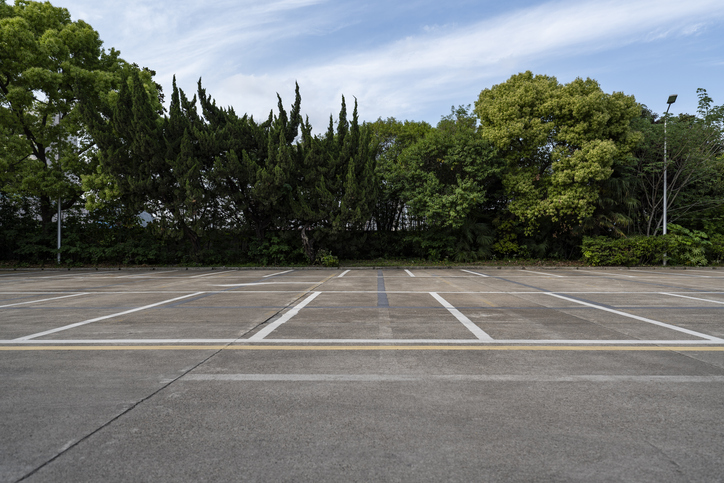Back to Basics: Parking Lot Maintenance
Back to Basics is an article series that highlights important but possibly overlooked information facilities management professionals should know.

Now that warmer weather is here, it’s the perfect time to clean, inspect, and improve your parking lot after a long winter! Whether you’re a facility manager at an educational campus, a hospital, or an office, a commercial, or an industrial complex, it’s likely that you maintain the parking lot for employees, vendors, and customers. But before doing major work, determine when your facility is the busiest, and plan your work for when it’s the slowest, which is typically during the summer.
Here are three ways you can maintain your parking lot:
1. Pavement
Ensure your parking lot’s pavement is properly maintained by keeping these tips in mind:
- Power sweeping: Remove loose debris, and vacuum debris from stormwater drainage structures. Power sweeping removes gravel, sand, dirt, and trash that could cause damage to the parking lot’s surface as vehicles run over them.
- Power wash: Power washing removes oil and grease, helping to maintain a clean and presentable appearance and preventing customers and workers from slipping and injuring themselves.
- Cracks: Cracks should be sealed to prevent slips, trips, and falls. If cracks aren’t fixed, water can get into them and make them bigger. Untreated cracks can also lead to potholes.
- Potholes: Speaking of potholes, they should be fixed right away. First, remove debris from the hole, fill it with new pavement, and compact it. Also, any bumps should be smoothed out, and a sealant should be applied.
- Striping and arrows: Touch up paint for parking lines and directional arrows, if needed. Also, make sure your parking lot follows Americans with Disabilities Act (ADA) requirements regarding striping and access aisles. To understand how the ADA impacts you, read “Back to Basics: The ADA’s Impact on Facility Compliance” on Facilities Management Advisor.
2. Signage
Your parking lot should have signage to help orient employees and customers and provide ordinance reminders:
- Identification: The U.S. Department of Veterans Affairs recommends that facilities with multiple parking lots assign each lot a specific color and have appropriate signage so it’s easy for people to remember where they parked. Other types of signs can indicate row numbers, names of parking lots, and who is allowed to park in that particular location (e.g., faculty and staff, students, or visitors). Make sure to upgrade any signage when necessary.
- Handicap: Replace handicap signage, if necessary, and ensure existing signs are easily identifiable. These signs should have a blue background with white text and identify handicapped parking, van-accessible parking, and access aisles.
- Space availability: In busy parking lots, consider installing electronic variable signage to show how many spaces are available. This would prevent drivers from having to drive around endlessly only to discover all spaces are full.
- Regulatory: Clean and wax all existing signage to extend its life, including “enter” and “exit,” directional, speed limit, no parking, stop, and restricted parking signs like “maintenance vehicle parking only.” Also, remove graffiti, and trim bushes that could block signs and prevent drivers and pedestrians from being able to read them.
3. Lighting and Security
Having adequate security measures and lighting can increase parking lot users’ safety, including drivers and pedestrians.
- Security: According to the Institute of Electrical and Electronics Engineers (IEEE), parking lot security technology can be as simple as a video camera or as complex as artificial intelligence (AI), blockchain technology, and imaging and sensor technologies.
- Replace lights: Burned-out and broken lights should be replaced both in the parking area and along pathways from the parking lot to the buildings. Replacing bulbs can be costly, as it involves obtaining a utility truck with a lift and work crew, so if bulbs burn out often, consider replacing metal halide lights with light-emitting diode (LED) lights, which last longer.
- Installing LED lights: The Home Depot reports that many parking lot owners use LED outdoor area lights for high energy efficiency, as they emit blue and white colors and can show details more effectively. The U.S. Department of Energy estimates that switching to LED lighting will reduce parking lot energy use by over 50% compared with typical lights, as well as reduce maintenance costs.
- Illuminating dumpsters and recycling: Ensure dumpsters and recycling receptacles are in well-lit areas and near the building to discourage illegal dumping.
- Light ordinances: Property owners should adhere to local light pollution ordinances, which can limit the type and amount of parking lot lighting.
Conclusion
By properly maintaining pavement, signage, lighting, and security during the usually quieter summer months, your parking lot can properly serve both your employees and your customers.
The post Back to Basics: Parking Lot Maintenance appeared first on Facilities Management Advisor.

